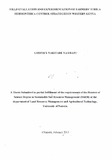Field evaluation and experimentation of farmers' striga hermonthica control strategies in western kenya

View/
Date
2013Author
Nambafu, Godfrey Nakitare
Type
ThesisLanguage
enMetadata
Show full item recordAbstract
Weed infestation in maize, especially the witch weed (Striga hermonthica), is a serious
problem in soils of western Kenya and thus low yield. Various control methods are in
place but their practice and adoptions by fanners are not widely studied. To this end, a
survey was carried out to synthesize farmers' knowledge, attitudes and practices in the
management of Striga hermonthica and to evaluate demographic and socioeconomic
factors that influence adoption of Striga control technologies under which informed
dissemination and subsequent adoption of new techniques was demonstrated through
field trials. A semi structured questionnaire was administered to 120 farmers, in
January 2012, in three districts (Busia, Kisumu West and Teso South) of western
Kenya. Additionally, field experiments were conducted to evaluate the effects of maize
variety and nitrogen sources on Striga parasitism and yield of maize. A randomized
complete block design (RCBD) with a split-split plot arrangement replicated six times,
with each district forming a block, was used. The main plots were fertility gradients
(high and low fertility) and the sub-plots comprised of maize variety (WS 303 and DH
04) while nitrogen fertilizer levels (d" and 60 kgNha-1
) were the sub-sub plots. The
parameters measured included maize emergence count, striga population count and
maize yield It was noted that an fanners were aware of Striga weed infestation with
99 % reporting to have Striga hermonthica on their farms. The spreading agents were
mentioned as; wind, animals, farm implements and water runoff, recording 25.8%,
25%, 10%, 6.7% respectively. Besides village meetings (45.9%), farmers got
information on Striga control strategies through neighbours (2.5%), workshops and
trainings (5.0%), field schools (3.7%), media (7.5%), and extension agents (10.8%).
Attitudes hindering adoption of Striga control technologies were reported as: long term
viability of the Striga weed seed making it difficult to control (12.5%), uncontrolled
sharing of farm tools (10.8%), expensive technologies (13.3%), lack of adequate
information (18.3%),. labour intensive (15.0%:1. requirement of large farms for
desmodium technology (1.7%) and time consuming (12.5%). Striga control
technologies that were employed by the farmers were: use of Striga weed resistant
Itolerant maize varieties (3.3%), intercropping maize with legumes followed with
cassava (1.7%), push and pull (2.5%) technology and traditional methods (25%).
Farmer's age, education, size of land and labour hiring were seen to be factors
affecting the adoption of striga weeds control technology. On-farm field trials revealed
highly significant differences between maize varieties and fertility gradients in terms
of striga population and yield of maize. Striga weeds emergence at 6 week after
planting (WAP) was low in all the plots in the three districts compared to striga
emerged in the 8 and ]0 WAP. In the 6 WAP, only a few plots had Striga weeds with
most of the plots recording zero score and the highest plot having 98,612 counts Iha.
WS 303 maize variety, treated with imazapyr, a systemic imidazolinone herbicide, had
the lowest Striga weed population at all counting levels (6th, 8th and 10th WAP). No
Striga were counted in all the WS 303 maize variety plots across the district in the 6
WAP. High maize yields were obtained where nitrogen and WS 303 maize variety
were applied and planted respectively. In plots where nitrogen was not applied and DH
04 maize variety planted recorded low yield, thus outweighing the consequences
(physical and monetary) of traditional farmer strategies of abandonment, fallowing or
crop substitution in heavily infested Striga weed fields. The findings from the two
levels of study (survey and field trials) were useful for developing sustainable Striga
weed control methods that fit the diversity of crop production practices. The Striga
control interventions that would simiiltaneously improve soil fertility and suppress the
development of Striga could be appealing to farmers. This includes use of Striga
resistant seeds alongside application of fertilizers, push and pulls technology and
intercropping cereals with legumes then followed with cassava
Citation
M.sc.Publisher
department of Land Resource Management and Agricultural Technology, University of Nairobi.
Description
Masters of Science Degree in Sustainable Soil Resource Management (SSRM)
